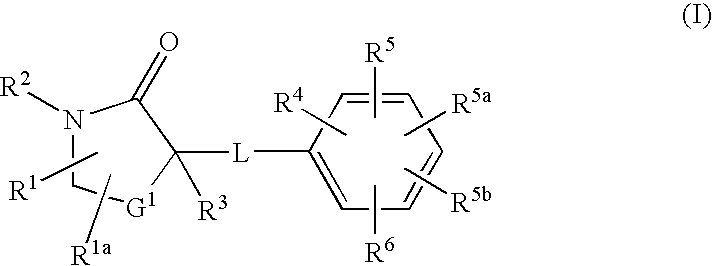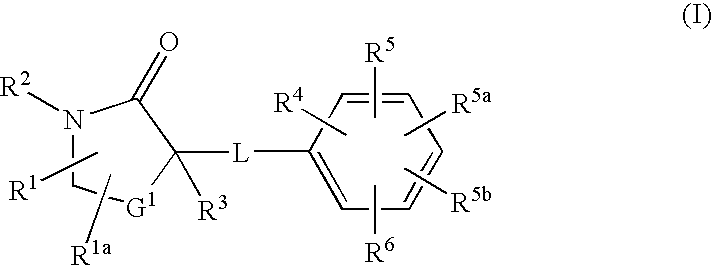Cycloalkyl lactam derivatives as inhibitors of 11-beta-hydroxysteroid dehydrogenase 1
a technology of cycloalkyl lactam and dehydrogenase 1, which is applied in the direction of drug compositions, biocide, metabolic disorders, etc., can solve the problems of reduced beta-cell function, reduced oxidation of glucose and glycogen in muscle, and insufficient activation of glucose uptake, so as to prevent apoptosis, improve beta-cell function, and improve fasting glucose
- Summary
- Abstract
- Description
- Claims
- Application Information
AI Technical Summary
Benefits of technology
Problems solved by technology
Method used
Image
Examples
preparation 1
3-Bromo-1-cyclohexyl-pyrrolidin-2-one
[0361]
[0362]Dissolve 2,4-dibromo-butyryl chloride (17.0 g, 64.3 mmol) in chloroform (3 ml) and add to a mixture of cyclohexylamine (7.65 g, 77.2 mmol) in chloroform (20 mL) and H2O (3 mL) at 0° C. Add sodium hydroxide (5.92 g, 147.9 mmol) slowly while keeping the reaction temperature below 10° C. Stir for 1 hour. Wash the organic layer with 0.5M hydrochloride and brine. Dry over sodium sulfate, filter, and concentrate. Place the residue in THF (200 mL) and cool to 0° C. Add sodium hydride (1.02 g, 42.6 mmol) and stir for two days. Add additional sodium hydride (1.02 g, 42.6 mmol) and stir for 3 days. Pour onto water and ice and extract with methylene chloride. Dry over sodium sulfate, filter, and concentrate to yield 6.36 g (34%) of the title compound: NMR (CDCl3) δ 4.41 (dd, 1H), 3.94 (m, 1H), 3.48 (m, 1H), 3.33 (m, 1H), 2.51 (m, 1H), 2.30 (m, 1H), 1.82 (m, 3H), 1.70 (m, 2H), 1.38 (m, 4H), 1.11 (m, 1H).
preparation 2
1-Cyclohexyl-4-hydroxymethyl-pyrrolidin-2-one
[0363]
[0364]Place 2-methylene-succinic acid (12.0 g, 92.2 mmol) and cyclohexylamine (9.15 g, 92.2 mmol) and heat to 160° C. for hours. Cool to give 18.8 g (96%) of 1-cyclohexyl-5-oxo-pyrrolidine-3-carboxylic acid. Charge a flask with 1-cyclohexyl-5-oxo-pyrrolidine-3-carboxylic acid (16.2 g, 76.7 mmol), add methylene chloride (20 mL) and cool to 0° C. Slowly add borane in THF (1M, 115.1 mL, 115.1 mmol) and stir for two hours at 0° C. Quench the reaction with ice and extract with methylene chloride. Dry over sodium sulfate, filter, and concentrate. Purify by silica gel (1-5% methanol in methylene chloride) to yield 9.9 g (65%) of the title compound: Mass spectrum (apci) m / z=198.1 (M+H).
preparation 3
1-Cyclohexyl-4-methyl-pyrrolidin-2-one
[0365]
[0366]Place 1-cyclohexyl-4-hydroxymethyl-pyrrolidin-2-one (Preparation 2) (2.5 g, 12.7 mmol) and triphenylphosphene (3.7 g, 13.9 mmol) in a flask and add dry N,N-dimethyl-acetamide (20 mL). Add a solution of iodine (3.2 g, 12.7 mol) in N,N-dimethyl-acetamide (3 mL). Stir reaction for 24 hours. Quench the reaction with saturated sodium bisulfite (20 mL) and extract with methylene chloride. Dry over sodium sulfate, filter, and concentrate. Dissolve crude material in acetonitrile (100 mL) and add glacial acetic acid (15 mL) and zinc (12.4 g, 190.1 mmol), then heat to 75° C. and stir for 6 hours. Cool to room temperature, filter, and partition between water and methylene chloride. Separate layers and wash methylene chloride with saturated sodium bicarbonate. Dry over sodium sulfate, filter, and concentrate. Purify by silica gel (30-40% ethyl acetate in hexane) to yield 1.0 g (45%) of the title compound. NMR (CDCl3) δ 3.94 (m, 1H), 3.45 (m, 1H)...
PUM
| Property | Measurement | Unit |
|---|---|---|
| temperature | aaaaa | aaaaa |
| particle size | aaaaa | aaaaa |
| temperature | aaaaa | aaaaa |
Abstract
Description
Claims
Application Information
 Login to View More
Login to View More - R&D
- Intellectual Property
- Life Sciences
- Materials
- Tech Scout
- Unparalleled Data Quality
- Higher Quality Content
- 60% Fewer Hallucinations
Browse by: Latest US Patents, China's latest patents, Technical Efficacy Thesaurus, Application Domain, Technology Topic, Popular Technical Reports.
© 2025 PatSnap. All rights reserved.Legal|Privacy policy|Modern Slavery Act Transparency Statement|Sitemap|About US| Contact US: help@patsnap.com



